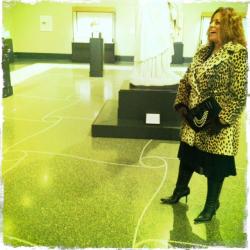
Mozuku, a refreshing, slightly crunchy marinated seaweed, featured at the RISING TOHOKU Food Fair. The Sendai Chamber of Commerce is showcasing 48 different meats, seafood, vegetables, fruits and desserts during the four-day event through Nov. 7 at Mitsuwa supermarket in Torrance.
“This taste warms the cockles of the heart.”
So says the wrapper of a Japanese green tea cream-filled dorayaki dessert pastry from Anchindo of Iwate Prefecture, in northern Japan. And it sums up the feeling one gets after sampling northern Japan delicacies at the “RISING TOHOKU Food Fair,” running now through Monday, Nov. 7, at the Mitsuwa supermarket-cum-food court complex on Western Avenue in Torrance.
Six cities in the Tohoku region, headed by Sendai in Miyagi, Prefecture, have teamed together to present a festival of authentic, super-fresh Japanese foods that can be enjoyed by all. The Sendai Chamber of Commerce alone is showcasing 48 different products at the event.

Performers from Tohoku, northern Japan present the Sendai Suzume dance during the RISING TOHOKU Food Fair at the Mitsuwa Japanese supermarket in Torrance, through Nov. 7.
RISING TOHOKU organizers have also invited dancers and musicians to show off signature moves and hearty yelps and cries that one often sees and hears at the summer festivals that take place during August in the cities of Aomori, Akita, Morioka, Yamagata, Fukushima and Sendai.
On Saturday, Nov. 5 – World Tsunami Awareness Day – the dancers and singers convinced one reporter’s elementary school daughter to put down her iPad and gaze at the beautiful costumes and lively, dynamic movements. She, like many others who attended a media event this morning, sat mesmerized by a unique Japanese subculture developed thousands of miles away on the other side of the Pacific.
You can find dorayaki, a Japanese style griddle cake typically filled with sweet azuki bean paste, pretty much anywhere in that country. But Anchindo does it with flair, folding the fist-sized pancake in half so that you can see the sweet filling oozing out before you bite into it. It’s sort of Japan’s response to the sweet-cream cannoli in Italian bakeries on the east coast of America.
On March 11, 2011, the Great Eastern Earthquake of Japan and tsunami ravaged large swaths of Tohoku, particularly coastal towns in Iwate, Miyagi and Fukushima prefectures, all of which are less than 200 miles north of Tokyo. But the food industry there is clearly back on its feet, eager to share its rich heritage and top-flight quality.
In the past, I had heard that “wagyu” (the word for Japanese cattle) from Iwate is considered to be even higher quality than Kobe beef, which is now part of the American lexicon to describe high-priced Japanese beef, beautifully marbled with fat. Now I know that Iwate wagyu (pronounced “EE-wah-tay) is exceptional.
Using a display kitchen inside the Mitsuwa store, onsite chefs prepare ultra-tender, mouthwatering strips of thinly cut Iwate-sourced wagyu on a bed of Iwate-grown rice that is airy light in texture. With shiso-flavored pickles and thin-cut green beans on the side, it made a perfect lunch.
Other unique offerings at the food fair include Kanno Tsukemono-branded miso-infused cheese from Minamisoma, Fukushima prefecture, using cream cheese imported from Australia; lightly marinated, slightly vinegary “mozuku,” a crisp, thin seaweed that is harvested in Okinawa, then processed in Sendai, Miyagi Prefecture; rice bowls topped with thinly sliced tuna caught by fishermen from the town of Kesennuma, Miyagi prefecture; and a brand new pasta made with natto, the fermented, highly nutritious sticky soybean loved by Japanese all across the northern parts of the archipelago.
Mr. Hideki Takayama, the secretary general of the Sendai Chamber of Commerce and Industry, gets his daily protein every morning from natto. His way of eating it: first beat it thoroughly with chopsticks to activate the gut-healthy natto bacteria, then add a little bit of leftover broth from boiling soba noodles as well as some finely chopped green onion.
Sendai is also home to what Takayama says are the finest-tasting raw oysters in the country. The oyster, scallop and hoya (sea squirt) fisheries have gotten back fully on their feet after the 2011 environmental disaster. Hiroshima in southern Japan is best known for the country’s best fried oysters. You’ll find a wide variety of smoked and frozen shellfish at the Tohoku fair.
“We are seeing a lot more European and American tourists revisiting Tohoku these days,” Takayama said. “In Tohoku you still have a lot of the old, traditional culture of Japan, unlike other cities south of us.”
Due to the warming of the oceans, Takayama notes that you don’t see the fine-tasting sanma Japanese mackerel off the coasts of Sendai these days. “They’re really small, so now you have to go up north to Hokkaido to catch them. But here in the waters off Sendai, you can now find the fish that use to inhabit the Tokyo area south of us.”


